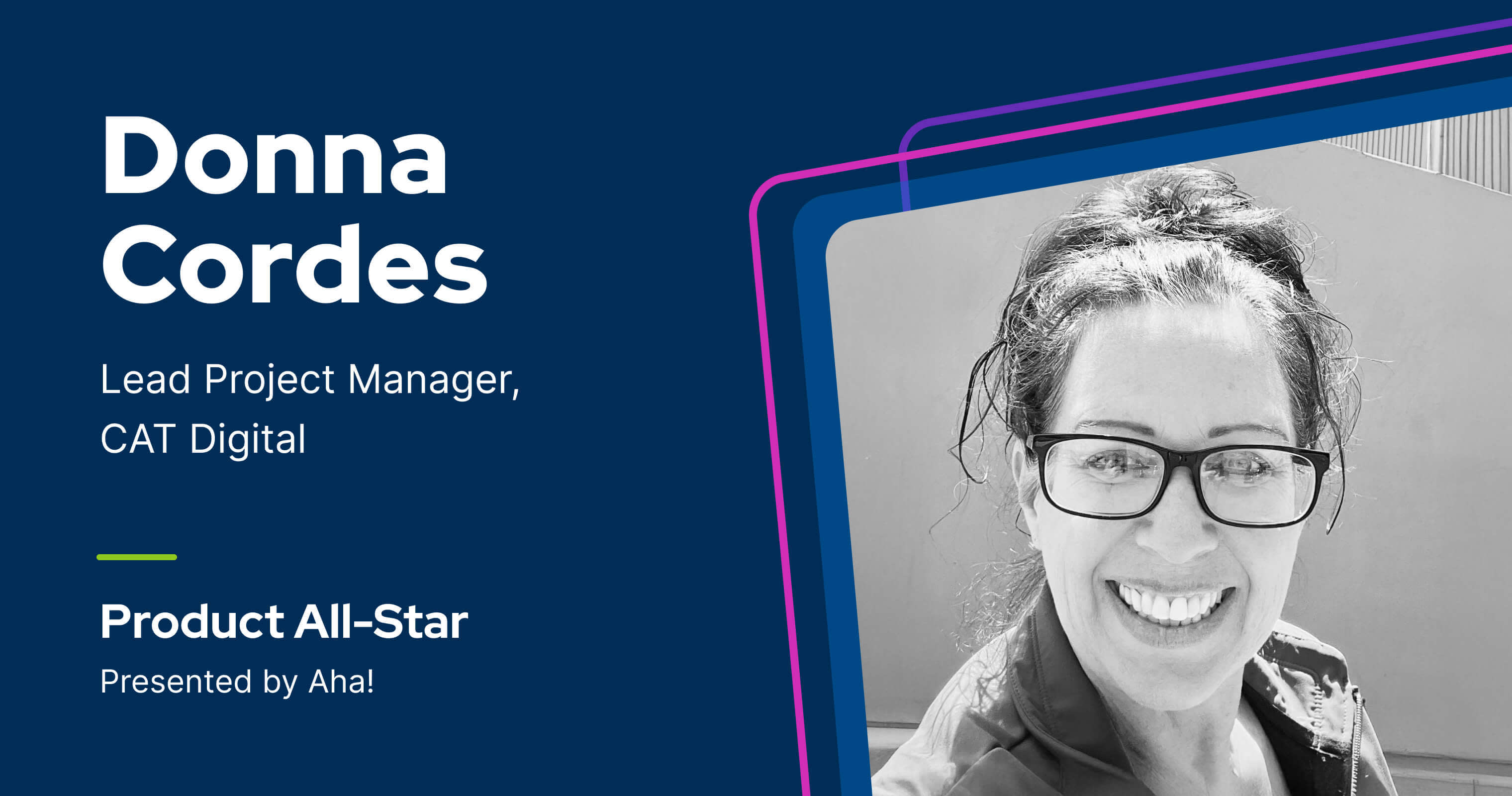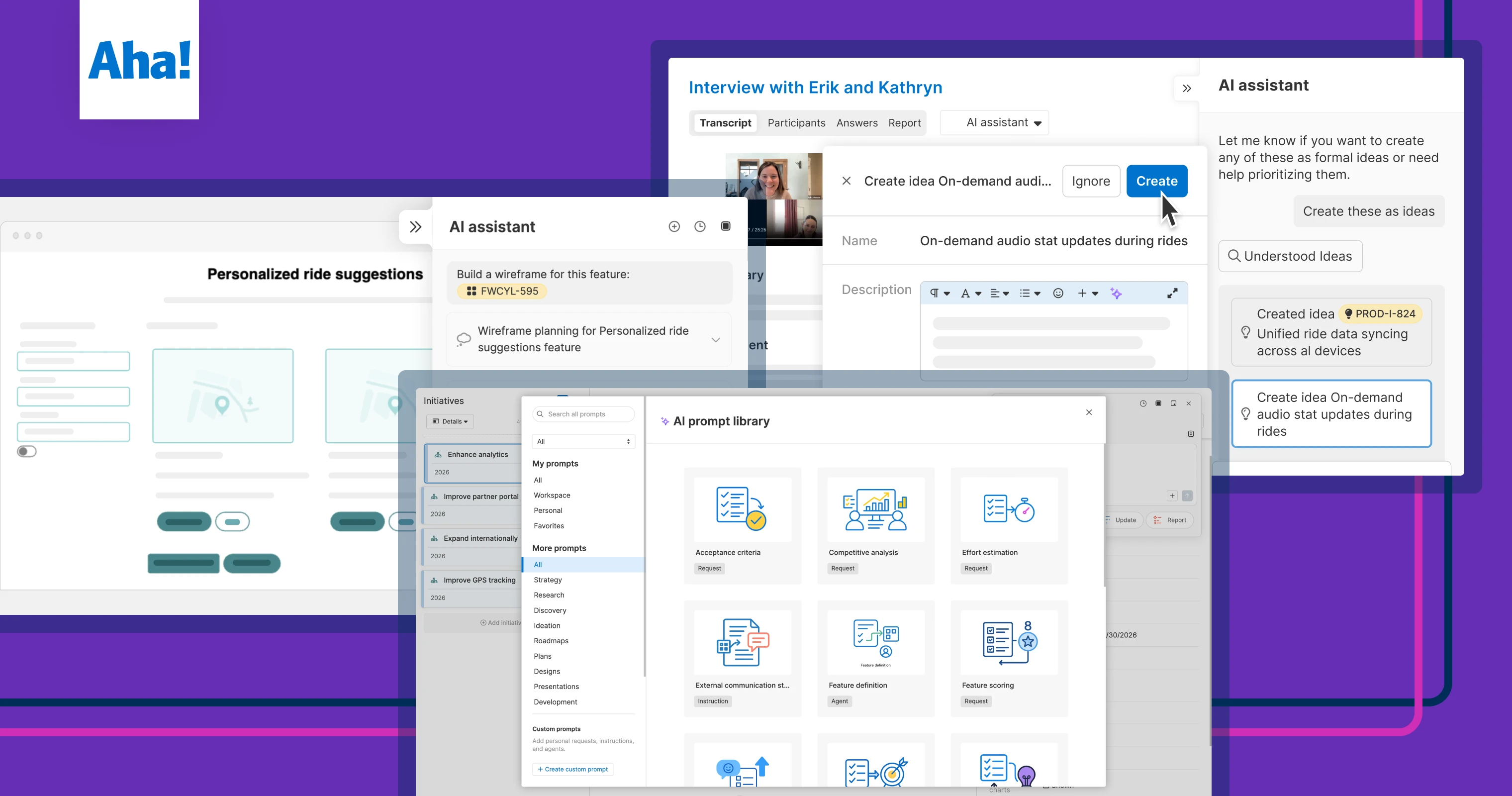
Human judgment + AI structure = a stronger launch plan. | Photo by Jodi B Photography
12 ways AI accelerates our product launches
A feature gets cut. The messaging shifts. A dependency falls behind. As launch day nears, you are cross-checking documents and pinging teammates to keep everyone aligned. A static launch checklist cannot keep up — it captures intent at one moment in time, but quickly becomes outdated. Launch planning needs to be dynamic.
Aha! software has always made that possible. You can link work across product, marketing, and customer teams so plans stay tied to the roadmap. Now, our AI assistant brings a new dimension with speed, precision, and contextual awareness. It can reference the data already in your account (including research, personas, roadmap items, and more) so you can make choices grounded in the latest work and customer feedback.
The future of launch planning is precise, immediate, and connected.
Along with the assistant, we also introduced an AI prompt library. The library offers ready-made prompts for common product tasks, and the assistant applies them directly to the data in your workspace. Teams already use these tools together to simplify planning and reduce the effort that used to go into constant revisions and coordination.
Say you are preparing to ship a major new feature. Feedback from customers highlights a use case you missed, or support raises concerns about missing documentation. Meanwhile, a dependency another team owns is now at risk of slipping. Because the AI assistant can work directly with the records in your account, it provides targeted suggestions that help you adapt quickly — refining messaging where needed, flagging potential risks, and reshaping the plan to stay on track.
AI is changing how every part of launch planning gets done, from personas to positioning to timelines.
Here is a closer look at how AI can enhance different aspects of launch planning, including sample prompts you can try today with the Aha! AI assistant:
Personas
Before: You need to update personas for this launch, but the work slows while you sort out which segments care most about the new capability.
After: Reference the personas already built in your Aha! account and let the assistant tailor drafts for this release — clarifying who to target and how to reach them.
Sample prompts:
"Review our existing personas in Aha! and adapt [persona] for the launch of [feature]. Show how this capability changes what matters to them."
"Based on these interview notes [discovery notes or document record] about [feature], predict [persona]'s reaction to this launch. Explore what they will care about most, likely objections, and buying triggers for [feature]."
How to ground the AI assistant: Point it to your saved personas, recent interview notes in Aha! Discovery, and supporting data already in your workspace.
Positioning and messaging
Before: Messaging starts from scratch, and teams suffer from delays and inconsistent talking points.
After: Share the context of this launch, including what the team will ship, who it is for, and why it matters. The assistant can also pull from connected strategy records and competitor notes to draft a positioning statement and message pillars specific to this release.
Sample prompts:
"Given our strategic initiative [initiative record] and competitive positioning [positioning record], draft a positioning statement and three messaging pillars for [feature]."
"Turn the three pillars into a short pitch for our sales team and a longer overview for the landing page. Reference this sales pitch [notes or document record] and website copy [notes or document record] from a recent launch of a similar feature [feature record]."
How to ground the AI assistant: Reference your strategic objectives, competitive analysis, and past launch messaging stored in Aha! software.
Channels and content focus
Before: Channel-planning balloons into a long list with no clear priorities.
After: The assistant can suggest a focused set of channels and content tied to your launch scope — showing which ones map to your goals, audience, and available assets.
Sample prompts:
"Recommend a channel plan for this launch. Reference the following marketing assets [notes or document records] for context: target audience, blogs, webinars, and timelines [Gantt chart].
"Based on our messaging pillars [positioning document], give six content ideas. Include working titles, target personas, content formats (blog, guide, demo, webinar, email, etc.), and CTAs."
How to ground the AI assistant: Reference past campaign performance data, your current marketing calendar, and available content assets in your workspace.
Risk scan
Before: A date changes in one place, but the update never reaches other teams, leaving key work at risk of slipping.
After: The assistant can scan features, estimates, and dependencies to flag risks tied to this launch — so you can adjust the plan and notify stakeholders early.
Sample prompts:
"Review the go-to-market roadmap for this launch [roadmap record] and surface any timing or dependency risks. Then, show me a risk summary, what work is affected, and suggested mitigations."
"Identify cross-team dependencies that could block this launch. Identify the owner, task, lead time, and suggested escalation path."
How to ground the assistant: Reference linked features, cross-team dependencies, and delivery estimates connected to your roadmap.
Sales enablement
Before: Sales requests materials late, and teams respond inconsistently to objections or use cases.
After: Generate a launch-specific enablement checklist early — aligning product, marketing, and sales around how this release helps customers and how to communicate its benefits effectively.
Sample prompts:
"Create a sales enablement checklist for [feature]. Use our ideal customer profile summary, key objections, pricing notes, and demo flow [notes or document records] for context. Then, provide essential assets, a quick-reference sales script, and the top five discovery questions."
"Draft five responses to likely customer objections related to [feature]. Include objections, responses, proof points, and suggested follow-up questions."
How to ground the AI assistant: Point it to win/loss notes, recent customer objections, and pricing or demo flows.
Launch communications timeline
Before: Communication is scattered, and important handoffs get missed.
After: Create a clear, coordinated timeline aligned to your launch — with defined owners and milestones that match the release scope.
Sample prompts:
"Build a four-week communications plan leading up to the launch of [feature]. Include week-by-week activities with owners and dependencies. Refer to strategic personas [strategic personas doc], channels, and available assets."
"Adjust this communications plan to match the scope and priority for this launch. Come up with a recommended communications scope, minimum asset set, and backup plan if a dependency slips."
How to ground the AI assistant: Reference your release record, marketing calendar, and any pre-scheduled content already tracked in Aha! software.
AI brings pace and pattern recognition — turning a static go-to-market plan into something that evolves with your launch.
Try the prompts above or use the pre-built options in our AI prompt library to see how the assistant can streamline your next launch. Bring in the details already stored in your account and tailor the output together as a team. No launch is perfect. But with AI, you can reduce rework, react faster, and keep everyone moving in the same direction. Happy planning!
Ready to get started? Learn more about the Aha! AI assistant and deliver better products, faster.




